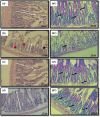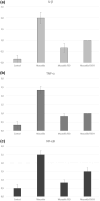Fig seed oil improves intestinal damage caused by 5-FU-induced mucositis in rats
- PMID: 39554361
- PMCID: PMC11561788
- DOI: 10.1002/fsn3.4283
Fig seed oil improves intestinal damage caused by 5-FU-induced mucositis in rats
Abstract
Intestinal mucositis poses a significant concern associated with cancer therapy. This study aims to investigate the protective and/or healing effect of fig seed oil (FSO) on 5-fluorouracil (5-FU)-induced intestinal mucositis by targeting inflammatory markers and histologic changes in rats. Albino Wistar adult rats were randomly divided into four groups, including three male and three female animals. All the animals in the four groups had a normal standard diet and water throughout the experimental period, which lasted up to 11 days. Rats were administered FSO 0.6 mL (mucositis FSO group) and FSO 0.2 mL (mucositis FSO-R group) daily throughout the experiment. These two groups and one additional group (mucositis group) were given an intraperitoneal injection of 5-FU (300 mg/kg) on Day 5 of the experiment. In contrast, the fourth group (Control group) was given an intraperitoneal saline injection on Day 5 of the experiment. FSO treatment ameliorated 5-FU-induced intestinal mucositis. On immunohistologic examination, FSO suppressed significantly the activation of NF-κB and expression of IL-β and TNF-α of the harvested intestinal tissue. The reduced dose FSO (mucositis FSO-R) was as effective as the full dose (mucositis FSO) in suppressing IL-β and TNF-α production, but was not as effective as the full dose in suppressing NF-κB. On light microscopy, FSO attenuated significantly 5-FU-induced anomalies, such as the reduction of intestinal villus length and Goblet cell count. The reduced dose FSO (mucositis FSO-R) was as effective as the full dose (mucositis FSO) in restoring villus length, but was not as effective as the full dose in restoring Goblet cell count. The findings of the study suggest that FSO inhibits 5-FU-induced intestinal mucositis via modulation of mucosal inflammation.
Keywords: chemotherapy; fig seed oil; fluorouracil; mucositis.
© 2024 The Author(s). Food Science & Nutrition published by Wiley Periodicals LLC.
Conflict of interest statement
The authors declare that they do not have any conflict of interest.
Figures





References
-
- Abou‐Elez Gawish, S. A. , Nosseir, D. A. , Omar, N. M. , & Sarhan, N. M. R. (2013). Protective effect of omega‐3 fatty acids on 5‐fluorouracil‐induced small intestinal damage in rats: Histological and histomorphometric study. Trends in Medical Research, 8(2), 36–62. 10.3923/tmr.2013.36.62 - DOI
-
- Akyuz, E. Y. , Akyuz, C. , Kiziltan, G. , Sehirli, A. O. , & Cetinel, S. (2018). The effects of oral nutritional formula enriched with arginine, omega‐3 fatty acids and nucleotides on methotrexate‐induced experimental intestinal mucositis. Progress in Nutrition, 20(2), 248–256. 10.23751/pn.v20i2.6396 - DOI
-
- Al Asmari, A. K. , Khan, A. Q. , Al Asmari, S. A. , Al Rawi, A. , & Al Omani, S. (2016). Alleviation of 5‐fluorouracil‐induced intestinal mucositis in rats by vitamin E via targeting oxidative stress and inflammatory markers. Journal of Complementary Integrative Medicine, 13(4), 377–385. 10.1515/jcim-2016-0043 - DOI - PubMed
-
- Allman, M. A. , Pena, M. M. , & Pang, D. (1995). Supplementation with flaxseed oil versus sunflower seed oil in healthy young men consuming a low fat diet: Effects on platelet composition and function. European Journal of Clinical Nutrition, 49(3), 169–178. - PubMed
LinkOut - more resources
Full Text Sources

